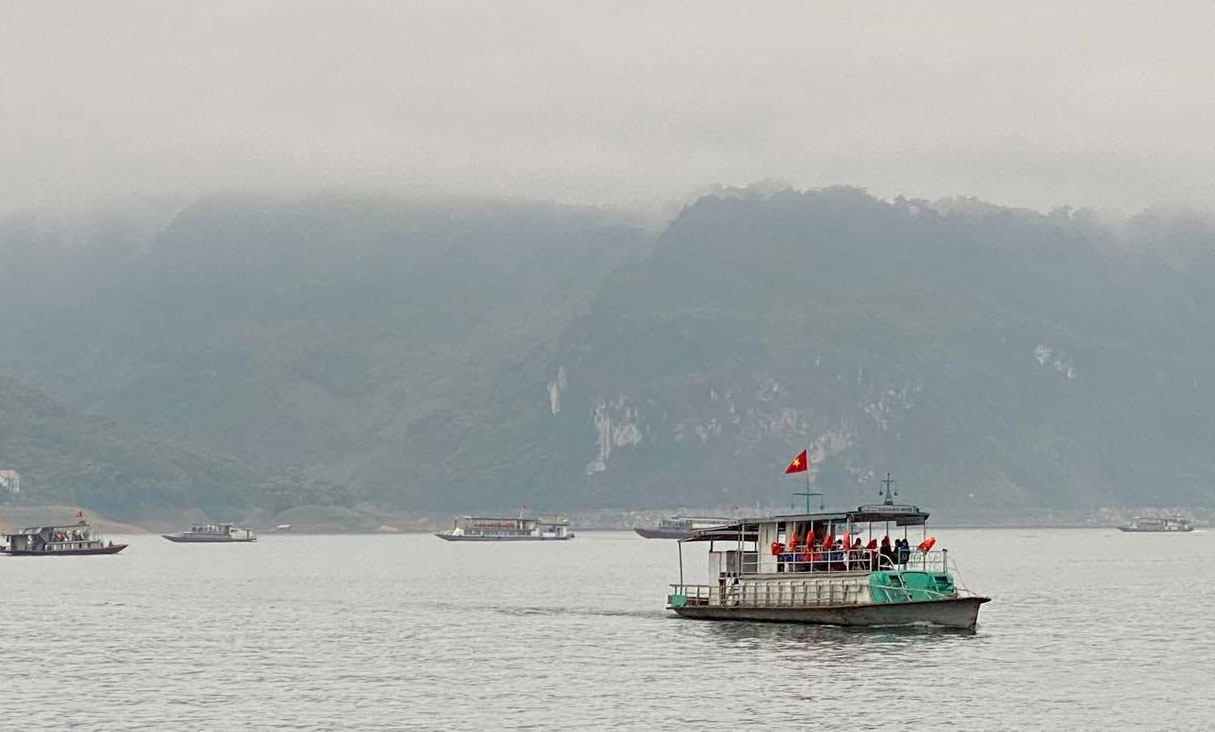



The tourism area of Hoa Binh Lake with many attractive destinations paints a vibrant tourism economic picture.
The changes in the community tourism villages
Coming back in Ngoi village in Suoi Hoa commune (Tan Lac), we couldn't help being surprised by the changes of Muong village. Mr. Bui Van Hien, the owner of Van Hien homestay said: In the past, the people in the village only relied on the forestry plantation and fishing on Hoa Binh Lake, the economy was mainly self-sufficient. Implementing the policy of tourism development, and with the attention and support of the province and some investors, 7 households in the village have boldly developed the type of homestay to welcome guests. Promoting what is bestowed by the nature, and along with the rich cultural identity of the Muong ethnic group, Ngoi village has become one of the cultural tourism attractions attracting domestic and foreign visitors. Thereby, people's living standards have improved, and per capita income has increased significantly.
The cultural identity is also the most attractive tourism product exploited by the Dao ethnic group in Sung village, Cao Son commune (Da Bac). It was once a desolate, remote and little-known place, the village of Dao community here has become a familiar name on the map of the tourism area within Hoa Binh Lake Through tourism, the agricultural products have been better consumed and they have been sold at higher prices; the households doing homestay business have had a stable source of guests, and their income has significantly been increasing. About 50 households in the village have been participating in community tourism activities.
According to Mr. Bui Xuan Truong, the Deputy Director of the Department of Culture, Sports and Tourism, the tourism economy has created a bright face in poor hamlets, communes and the areas of the ethnic minority. There are 21 communes of Da Bac, Cao Phong, Tan Lac, Mai Chau and Hoa Binh city with 6 main ethnic groups including Muong, Thai, Kinh, Tay, Dao, and Mong are stretching along the tourism area within Hoa Binh lake. Before 2015, per capita income in the communes within the Tourism Area of Hoa Binh lake was much lower than the provincial average, now the gap has been narrowed. Compared to the agricultural and industrial sectors, service and tourism in the tourism area within Hoa Binh Lake have accounted for a higher proportion.
Trying to become a spearhead economic sector
In addition to implementing the project of restructuring the tourism industry, developing it into a spearhead economic sector of the province and the tourism development project of the districts and the city, the Culture, Sports and Tourism sector has implemented the administrative reform, facilitating the investment procedures; advising on the development of the specific policies of the province to attract investment in tourism development; strengthening the management and protection of resources and tourism environment; supporting the organizations, the businesses and the people to participate in tourism economic development; organizing propaganda activities, promoting Hoa Binh tourism...
Up till now, the tourism infrastructure connecting tourism areas and attractions in the area with other provinces in the region has been paid attention to, attracting a number of domestic and foreign investors to set up investment projects for developing tourism in Hoa Binh. They include Cable car project and golf course entertainment complex in Hoa Binh city; Mai Da Resort and the project of afforestation combined with eco-tourism and resort in Hien Luong (Da Bac); eco-tourism and resort witinh Hoa Binh lake and Ho Guom Song Da eco-tourism park (Tan Lac)…
Currently, in the province there are 72 valid tourism investment projects, accounting for 12.2% of the total number of investment projects in the province, with a total registered investment capital of about 20,594 billion VND. The quality of tourism products has increasingly improved. In particular, a walking and cycling tour along the two banks of the Da River in the direction of Hoa Binh City to Da Bac has been opened in the toyrism area within Hoa Binh lake, building a weekend resort program and an experience program on the lake.
Hoa Binh tourism is gradually achieving the basic criteria to become an important economic sector of the province. Notably, the tourism area within Hoa Binh Lake has initially met some conditions to become a national tourism resort. The number of tourists and the total revenue from tourism of the province have a good average growth rate, reaching over 10% per year, it only decreased in 2020 due to the impact of Covid-19 epidemics.
The province's tourism has been oriented to develop in the spirit of the Resolution of the 17th Provincial Party Congress, term 2020 - 2025. Accordingly, it is nêcsary to maximize its advantages to develop tourism into a spearhead economic sector, building attractive destinations with the typical tourism products; developing in a sustainable way, closely being associated with the conservation and promotion of the ethnic cultural identities, preserving the landscape and environmental protection; diversifying the tourism products associated with promoting the local culture, potentials and advantages and building new countryside; focusing on exploiting the market in Hanoi Capital region in parallel with expanding domestic and international markets...